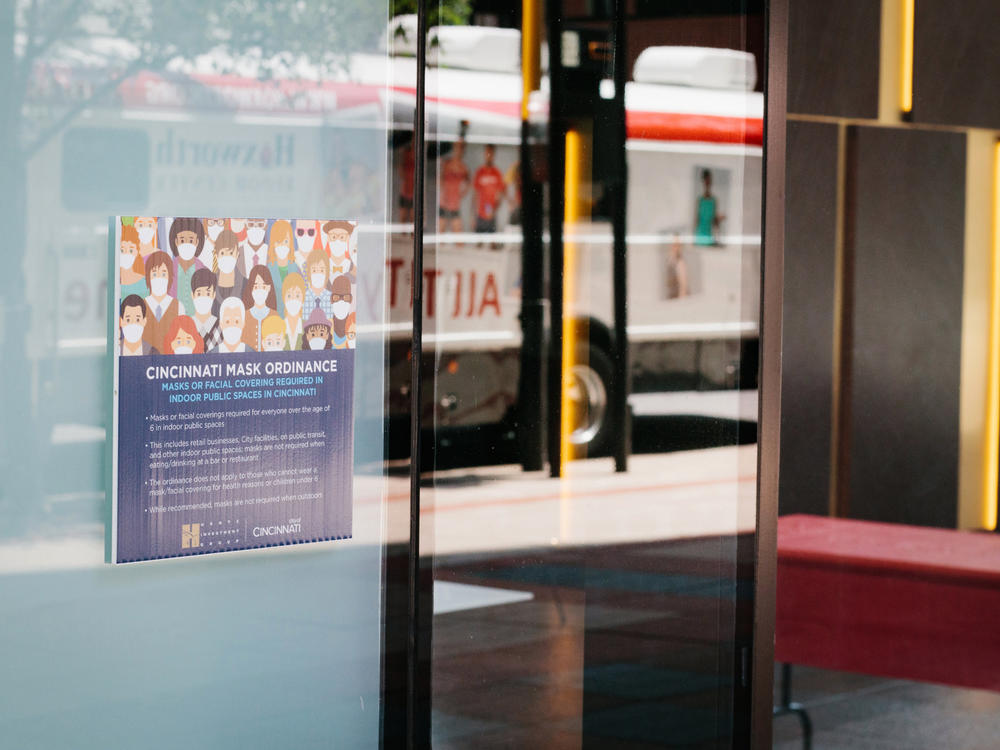Section Branding
Header Content
Masking Up In The Midwest With New Statewide Mandates
Primary Content
Updated at 11:51 p.m. ET
Three Midwestern governors announced statewide face covering mandates on Wednesday, adding Minnesota, Ohio and Indiana to the growing list of states requiring people to mask up in public.
Ohio's order takes effect at 6 p.m. Thursday, Minnesota's starts on Saturday, and Indiana's on Monday.
The governors present masks as a critical tool in protecting public health and allowing activities like school and sports to proceed in the fall. Ohio Gov. Mike DeWine also cited guidance from Centers for Disease Control and Prevention Director Robert Redfield that wearing masks could get the virus' spread under control within several weeks.
Face coverings have been required in certain Ohio counties designated high-risk since earlier this month. By July 16, mask mandates applied to 19 counties, encompassing nearly 60% of the state's population.
The statewide order requires people over the age of 10 to wear masks in public, both indoors and outdoors where social distancing is not possible.
There are exceptions for people with medical conditions, as well as those who are "actively involved in public safety" and officiating religious services. Masks are not required when people are actively eating, drinking, playing sports or exercising.
Ohio recorded 1,527 new coronavirus cases, 16 new deaths, 128 new hospitalizations and 19 new intensive care unit admissions on Tuesday.
"Wearing masks will make a difference," DeWine wrote in a tweet. "It will determine what our fall looks like. We want kids to go back to school, we want to see sports — to do that it's very important that all Ohioans wear a mask."
In Minnesota, Gov. Tim Walz's executive order will require people to wear face coverings in all indoor public spaces and businesses, unless they are alone. Workers will also be required to wear masks when working outdoors in situations where social distancing cannot be maintained.
There are some exceptions to the order, such as for children under the age of two and people with certain underlying conditions.
Violators will face consequences including misdemeanor citations and fines for individuals and criminal, civil and regulatory sanctions for businesses.
The Minnesota health department reported 507 new cases and four deaths on Wednesday, bringing the state's totals to nearly 47,961 cumulative cases and 1,552 deaths.
Walz said at a briefing that face coverings are the "cheapest and most effective" way to protect both lives and businesses.
"In the long run, this is the quickest way to ending the COVID pandemic," he said. "It is the surest way to getting us to the therapeutics and the vaccines, with the least amount of impact on Minnesotans, and it is the absolute economic key to making sure that businesses are open and stay open."
He also encouraged Minnesotans to view the mask mandate and similar steps as "just the way we do business," comparing it to other newer norms like prohibiting smoking indoors, wearing seat belts in cars and facing penalties for distracted driving.
Indiana Gov. Eric Holcomb said the order will require Hoosiers over the age of eight to wear masks in most public settings. Face coverings will also be required in schools for students in third grade and above, as well as faculty, staff, volunteers and visitors.
"The state will approach enforcement of the face covering requirement with an emphasis on education," he added.
Indiana reported 763 new cases and 14 deaths on Wednesday.
Masks are gradually becoming the standard in many parts of the country, with many states, localities and businesses requiring people to wear them. At a briefing on Tuesday, President Trump urged people to mask up, something he himself had previously been reluctant to do.
In the Midwest, Illinois, Michigan and Kansas already have statewide mask orders in place. And some of Ohio's neighbors —Pennsylvania, Kentucky and West Virginia — have also enacted similar mandates.
In the East, Washington, D.C., Mayor Muriel Bowser also announced expanded mask-wearing requirements on Tuesday. Effective immediately, people must wear masks when they leave their homes "if they are likely to come into contact with another person for more than a fleeting moment."
The latest batch of orders comes as coronavirus cases continue their nationwide climb.
The Centers for Disease Control and Prevention said that in the week leading up to July 21, 10 states reported more than 10,000 new cases, with three states — California, Texas and Florida — each reporting more than 60,000.
Copyright 2020 NPR. To see more, visit https://www.npr.org.

